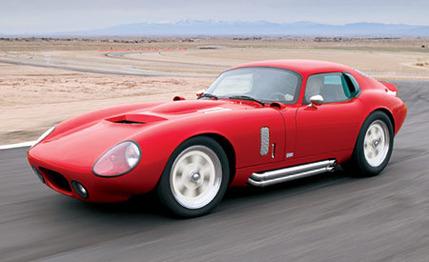
 Specialty File
Specialty File
It was early on a Thursday morning when Peter Brock pulled the Superformance Brock coupe into the parking lot of a fast-food joint in Temecula, California, where we were waiting. As the Torch Red coupe rumbled slowly to a halt, bystanders were transfixed at the sight. We couldn't help recalling that the Shelby team's response in 1963 to Brock's original drawings was that it was the ugliest car they'd ever seen. Chew carefully as you eat those words, guys.
Because Shelby's team doubted the potential of Brock's Cobra-roadster-based exotic coupe with its chopped-off Kammtail, they left its construction to a small triumvirate of believers. Brock, British driver Ken Miles, and Kiwi mechanic John Ohlsen were left to put it together for its first race at Daytona in February 1964.
In many ways, this new fiberglass replica is a vindication of Peter Brock's original vision. You see, despite the enlarged cockpit dimensions made possible by this latest redesign, the Superformance car is closer in concept to Brock's original than even the first race cars were.
From the outset, Brock would have preferred to increase the wheelbase and move the Cobra underfloor frame tubes so the occupants' seats could drop lower into the chassis, but that idea contravened the racing regulations of the time. So the first Daytona coupes were built on AC Cobra chassis with minimal changes to the layout, resulting in cockpits that were fairly confined.
That has all changed with this Brock redesign. He moved the floor rails outward, dropping the seats by four inches. The wheelbase was stretched by three inches, and the height and width of the car were increased proportionally. Windshield rake and curvature were changed to take advantage of modern glass, and the result is a shape that is arguably better proportioned than the aluminum-skinned originals. Some of those were built to the wrong dimensions anyway, when Italian coachbuilders at Carrozzeria Gransport believed they were correcting a design error, inadvertently making enough space for a lanky Dan Gurney to squeeze behind the wheel.
There's room for Gurney in this new Brock coupe, too, that's for sure. If this six-foot-five tester can slip into the driver's seat with a broken left ankle (don't ask), then almost anyone can. Legroom is plentiful, and the wheel is at a comfortable reach and angle. The passenger footwell is somewhat abbreviated by the air-conditioning system housed up front but is ameliorated by a reasonable dashboard height that allows one's knees to bend a little before they contact the lower edges.
Looking around when seated in this car, one sees beautifully executed interior panels and materials. Brock says the interior design is "period, but not race-car fashion." The dash is coated with a vinyl skin and capped with a suedelike material. The headliner is thick and plush, and the craftsmanship throughout the car redefines the term "kit car." To fully appreciate it, says Brock, you have to meet the owner of Hi-Tech Industries, which owns the old AC Cars patents and builds the rolling chassis in Port Elizabeth, South Africa.
His name is Jim Price, and when he first approached Peter Brock to do a redesign of the Daytona coupe, Brock turned him down, not wanting to be part of a kit-car reincarnation. Price responded by saying he wouldn't do the car without Brock's participation. He'd only do it if they could do it right, he said, and that got Brock's attention. When Brock insisted on using Bob Negstad, the original chassis designer for the Cobra 427, Price didn't quibble, even though that meant contracting Roush Industries (where Negstad was working) at a cost of some $140,000 for the job.
Negstad's ambitions with the 427 project had also been thwarted when his extended-wheelbase design was preempted by AC Cars technicians in Britain, who prematurely cut frame tubes to the usual size. This new chassis is a tubular mild-steel space frame with double control arms up front and upper A-arms with lower links in the rear, and its rigidity is claimed to be in the same realm as a C4 Corvette's, at 6000 pound-feet per degree of deflection.